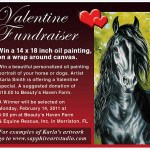GEORGETOWN, KY – JANUARY 6, 2011 – Polish Navy, the Ogden Phipps homebred and GR1 winner, was humanely euthanized this morning at Old Friends Thoroughbred Retirement facility in Georgetown, KY. He was suffering from complications from a hip injury.
Michael Blowen, Old Friends President and Founder, made the announcement this afternoon.
“Polish Navy injured his hip several weeks ago and was taken to Hagyard’s where he received excellent diagnostic care,” said Blowen. “Unfortunately, he just never recovered. Dr. Doug Byars visited with this great old horse several times and, in consultation with Old Friends, advised us that Polish Navy’s time had come.”
The 27-year-old stallion had been pensioned at Old Friends since 2009.
Continue reading Stakes Winner Polish Navy Euthanized at Old Friends





